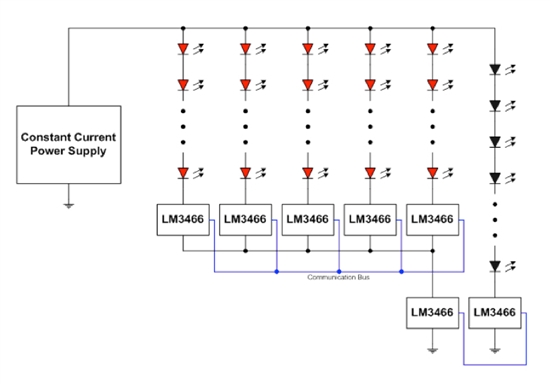Joe DeNicholas, Product Line Manager, Lighting Power Products, Texas Instruments (TI) tackles some common issues in Multi-string LED lighting systems in this Power House blog entry.
Prior to the invention of dynamically adjusted high power linear regulator devices, designers of LED electronics basically had two options for the configuration of multiple LED strings:
-
Regulate each string individually with a switching regulator, or
-
Take your chances with a series-parallel configuration
Regulating every string with a switching regulator, typically in a buck configuration, offers the maximum level of flexibility with respect to supply variation, LED stack voltage variation and fault protection. But, having a switching regulator on every string can be expensive and unnecessary if the LED strings match each other in forward voltage relatively well. Alternatively, placing the strings in a series-parallel configuration requires the forward voltage and dynamic impedance of the strings to match much more tightly, otherwise it will lead to significant mismatch in string currents and decreased reliability. This requirement can also increase the cost of the LEDs due to forward voltage binning requirements now placed on the LEDs.
At Texas Instruments, we are always looking for ways to maintain or improve the performance of LED lighting systems while reducing cost. Our family of high power linear regulator devices, namely the LM3463, LM3464, and LM3466, solve the challenges of designing multi-string LED applications by providing a low cost, efficient way to ensure current matching between strings.
 |
|
LM3466 Driver in a multi-string LED configuration. (LEDinside/Texas Instruments) |
An alternative is to use a linear regulator in order to provide a ballasting function that will force the strings to match in current, as well as provide increased fault protection. If the incoming power supply, be it AC/DC or DC/DC, provides a constant voltage, then the LM3463 and LM3464 LED drivers would be the right choice. However, if the incoming supply provides a constant current, the LM3466 is the right choice. A typical application schematic is shown below:
 |
|
A LM3466 LED driver in a multi-string LED configuration. (LEDinside/Texas Instruments) |
In this application, the LM3466 integrated circuits communicate with each other to ensure that the incoming current, being forced by the constant current supply, is distributed equally across the strings. The linear regulator absorbs any difference in LED stack forward voltage.
Question #1 - But, aren’t linear regulators inefficient?
The best answer is, “sometimes, but not always.” Linear current regulators are inefficient when the input and output voltages are mismatched, but if the voltages are close, they can actually be very efficient. All of the products in this family, including theLM3466, operate to ensure very high efficiency. In fact, the conversion efficiency for one of our linear stages will be higher than the majority of switching regulator-based conversions!
Question #2 - What about fault protection?
Though LED reliability is improving, we still need to be concerned about fault protection to ensure that systems behave gracefully in the event of a fault. All of our linear regulator-based solutions include open and shorted LED protection methods to ensure reliable and safe operation. Each device’s datasheet contains thorough information regarding fault-handling capabilities.
Question #3 - What if I want different currents in different strings?
As long as the forward voltage of the strings is close enough such that they don’t stress the linear regulators with excessive power dissipation, no problem. In the case of an LM3466 based system, each circuit uses a programming resistor that determines the ratio between strings. So, the currents don’t have to be equal as in the example discussed above. If the string forward voltages are too different, a switching regulator is required.
Question #4 - I have multiple strings of two different types of LEDs that require different currents, does this mean I can’t use the LM3466?
No, but there are some limitations. For example, a circuit that would support one high brightness white string at 500mA and five red strings that require 100mA each is shown below.
In this case, if the constant current supply sends 1A, the five color strings are forced to be equal at 100mA each, and the sum of the five strings is forced to be equal at 500mA to the high power white string.
The LM3466 offers an efficient, low noise, low cost, and easy way to drive a variety of multi-string LED configurations. Give it a try and let me know how well it works for you. You can see TI's complete LED lighting portfolio here.













